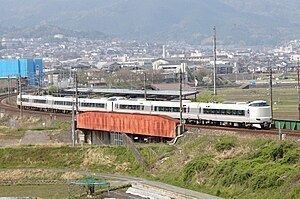Current operator(s) JR West Operating speed | First service 1962 Line used Sanin Main Line | |
 | ||
Rolling stock 287 series, 289 series EMUs | ||
The Kinosaki (きのさき) is a limited express train service operated by West Japan Railway Company (JR West). One of the services making up JR West's "Big X Network", it connects Kyoto Station and Kinosaki Onsen Station via the Sanin Main Line. The color associated with the service is purple, also the line color of the Sagano Line which it uses for part of its journey.
Contents
Station stops
Kyoto - Nijō - Kameoka - Sonobe - Hiyoshi - Ayabe - Fukuchiyama - Wadayama - Yōka - Ebara - Toyooka - Kinosaki Onsen
Maximum operating speeds
Rolling stock
Kinosaki services are operated with 287 series electric multiple unit (EMU) trains based at Fukuchiyama Depot. Some services operate as combined Kinosaki and Maizuru services. The 287 series EMUs were introduced on these services from 12 March 2011, replacing 183 series sets.
289 series EMUs converted from former dual-voltage 683 series trainsets were introduced on Kinosaki services from 31 October 2015, replacing the remaining JNR-era 381 series trains.
Former
183 series EMUs were formerly used on some services, but were withdrawn by the start of the revised timetable on 16 March 2013.
Fukuchiyama-based 381 series EMUs displaced from Kuroshio services were also introduced on Kinosaki services from 1 June 2012. These were withdrawn following the final day of operations on 30 October 2015.
History
The Kinosaki service is named after the service's terminus, formerly known only as Kinosaki Station. Also, when the service began, the neighborhood in which the station stood was known as Kinosaki. Both are derived from the region's well-known area of hot springs.
